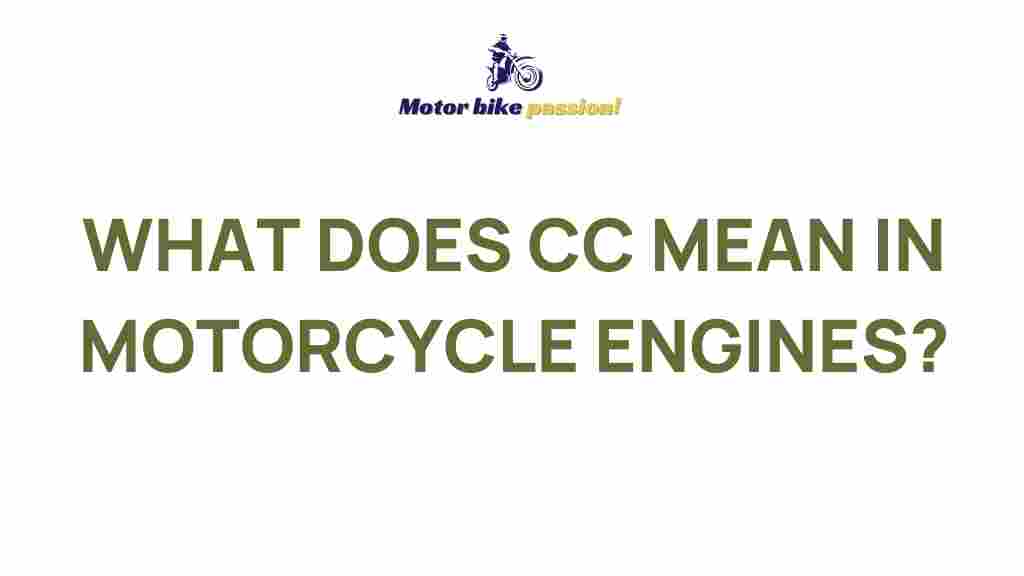Unraveling the Mystery: What Does CC Mean in Motorcycle Engines?
When it comes to motorcycle engines, enthusiasts and novices alike often encounter the term “CC.” But what does it really mean? Understanding CC, or cubic centimeters, is crucial for anyone looking to buy, ride, or maintain a motorcycle. This article will delve into the significance of CC in motorcycle engines, how it relates to horsepower and engine displacement, and why it matters for performance and riding experience.
Understanding CC: The Basics
CC stands for cubic centimeters, a unit of measurement used to describe the volume of the engine’s cylinders. The size of a motorcycle engine is often expressed in CC, and it directly impacts the engine’s power output, fuel efficiency, and overall performance. In essence, the larger the CC, the more air and fuel the engine can combust, leading to greater power output.
How Engine Displacement Works
Engine displacement refers to the total volume of all the cylinders in a motorcycle engine. It is calculated using the formula:
Engine Displacement (CC) = π/4 × Bore² × Stroke × Number of Cylinders
- Bore: The diameter of the cylinder.
- Stroke: The distance the piston travels within the cylinder.
- Number of Cylinders: The total number of cylinders in the engine.
The displacement is a critical factor because it influences the engine’s ability to produce power. Generally, a higher displacement means more power, but it also often leads to lower fuel efficiency.
The Relationship Between CC and Horsepower
Horsepower is a measurement of an engine’s power output. While CC gives you an idea of the engine size, it does not directly equate to horsepower. Several factors influence horsepower, including:
- Engine Design: Different designs can produce different power outputs from the same displacement.
- Fuel Type: Higher octane fuels can help engines produce more horsepower.
- Tuning: An engine that is specifically tuned for performance can generate more horsepower from the same CC.
For example, a 600 CC sportbike may produce significantly more horsepower than a 600 CC cruiser due to design and tuning differences. Therefore, while CC is a useful measure, it should be considered alongside horsepower for a complete understanding of a motorcycle’s performance.
Factors Influencing Engine Displacement
Several factors contribute to the overall displacement of motorcycle engines. Understanding these can help riders make informed decisions when selecting a motorcycle.
1. Engine Configuration
The way the engine is configured plays a crucial role in determining its displacement. Common configurations include:
- Single Cylinder: Simple design, typically lower CC but can be very efficient.
- Parallel Twin: More power than singles, popular in many mid-range motorcycles.
- V-Twin: Provides great torque, often found in cruisers.
- Inline Four: Common in sportbikes, delivering high RPMs and power.
2. Bore and Stroke Ratios
The relationship between the bore and stroke can greatly influence the characteristics of a motorcycle engine. A larger bore allows for more airflow, while a longer stroke can improve torque delivery. Manufacturers often balance these two to achieve the desired performance traits.
3. Turbochargers and Superchargers
Some motorcycles utilize forced induction systems, such as turbochargers or superchargers, to increase the power output without significantly increasing the CC. These systems compress the intake air, allowing for more fuel to be burned and thus increasing horsepower.
Choosing the Right CC for Your Needs
When selecting a motorcycle, understanding how CC affects performance is essential. Here are some considerations:
1. Riding Experience
For beginners, a motorcycle with a lower CC (250-500 CC) is usually recommended. These bikes are easier to handle and less intimidating for new riders.
2. Intended Use
Consider how you plan to use your motorcycle:
- Commuting: Smaller engines (250-400 CC) are often more fuel-efficient and easier to maneuver in traffic.
- Long-Distance Touring: Larger displacement bikes (600 CC and above) provide better comfort and power for long rides.
- Sport Riding: Sportbikes with mid to high CC (600-1000 CC) offer agility and speed.
3. Insurance and Licensing
In many regions, motorcycle licensing and insurance costs can be influenced by engine size. Larger CC motorcycles may require more extensive licensing and can lead to higher insurance premiums.
Troubleshooting Common CC-Related Issues
Understanding CC can help you troubleshoot problems related to engine performance. Here are some common issues and their potential solutions:
1. Lack of Power
If your motorcycle feels underpowered, it may not necessarily be due to its CC. Consider checking:
- Air Filter: A clogged air filter can restrict airflow, affecting performance.
- Fuel Quality: Ensure you are using the right fuel type for your engine.
- Spark Plugs: Worn or fouled spark plugs can lead to poor combustion.
2. Poor Fuel Economy
Higher CC engines can consume more fuel, but if you notice a significant drop in fuel efficiency, check:
- Carburetor or Fuel Injection System: An improperly tuned system can lead to excessive fuel consumption.
- Tire Pressure: Low tire pressure increases rolling resistance, impacting fuel economy.
3. Engine Overheating
Overheating can be a sign of several issues, including:
- Coolant Levels: Make sure the cooling system has adequate coolant.
- Thermostat Issues: A malfunctioning thermostat can prevent proper engine cooling.
For more detailed troubleshooting tips, check out this comprehensive motorcycle maintenance guide.
Conclusion
Understanding what CC means in motorcycle engines is fundamental for anyone involved in the world of motorcycles. CC, or cubic centimeters, provides insight into engine displacement, which directly influences horsepower and overall performance. Whether you are a beginner or an experienced rider, knowing how to choose the right CC for your needs can enhance your riding experience.
Always consider your riding style, experience level, and intended use when evaluating motorcycle engines. With the right knowledge, you can make informed decisions that will lead to enjoyable and safe rides.
For more information on motorcycle specifications and performance, you can visit Motorcycle Specifications.
This article is in the category Maintenance Tips and created by MotorBikePassion Team
